Portal:Religion/Selected picture
Usage
[edit]The layout design for these subpages is at Portal:Religion/Selected picture/Layout.
- Add a new Selected picture to the next available subpage.
- Update "max=" to new total for its {{Random portal component}} on the main page.
Selected pictures list
[edit]Pictures 1–20
[edit]Portal:Religion/Selected picture/1

The Cistercian Abbey of Senanque, home of a Roman Catholic order of enclosed monks looking to cultivate a monastic community in which they could carry out their lives in stricter observance of The Rules of Saint Benedict.
Portal:Religion/Selected picture/2
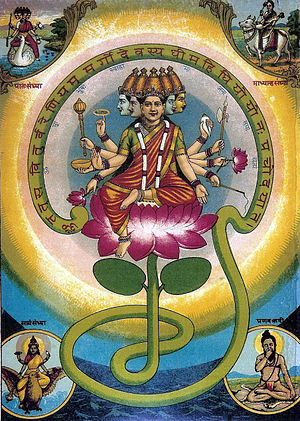
Gayatri is a poetic form used in the sacred texts of Hinduism. It also is one mantra in particular, attributed to Vishwamitra, and a goddess as its personification, a representation of the Parabrahman.
Portal:Religion/Selected picture/3
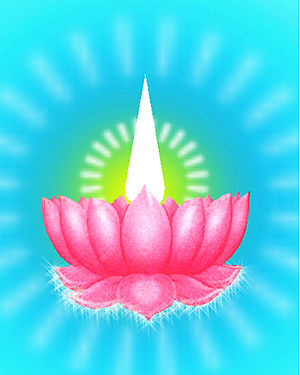
Lotus with Soul is the symbol of Ayyavazhi, a monistic religion, originated in South India in the mid 19th century, centred on Ayya Vaikundar and on his life and teachings as present in Ayyavazhi scriptures.
Portal:Religion/Selected picture/4

Norse (and more generally Germanic) God of Thunder Thor battling against the giants.
Portal:Religion/Selected picture/5

A Nizhal Thangal near Marthandam, Tamil Nadu. It is a simple temple of the Ayyavazhi, built per the instructions of Akilattirattu Ammanai by commoners in order to worship without distinction of color, race or caste. Cleanliness is strictly enforced: there are no sacrifices, no incenses, no arathi and no poojari.
Portal:Religion/Selected picture/6

The Taijitu (Chinese: 太極圖; pinyin: Taìjí tú; Wade–Giles: T'ai4 chi2 t'u2; lit. 'diagram of the supreme ultimate'), often incorrectly called a yin-yang, is a well known symbol deriving from Chinese culture which represents the principle of yin and yang from Taoist and Neo-Confucian philosophy. The term Taijitu itself refers to any of several schematic diagrams representing these principles.
Portal:Religion/Selected picture/7

The star and crescent is a symbol consisting of a crescent with a star at the concave side. In its modern form, the star is usually shown with five points (though in earlier centuries a higher number of points was often used). The two signs together or the crescent only is often regarded as a symbol of Islam.
Portal:Religion/Selected picture/8
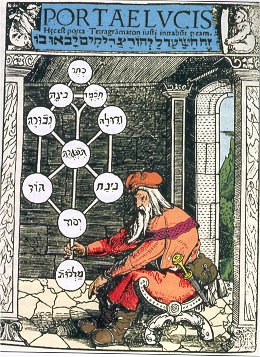
The Tree of Life (Heb. עץ החיים Etz haChayim), in the Book of Genesis, is a tree in the Garden of Eden whose fruit gives everlasting life, i.e. immortality. After eating from the Tree of Knowledge of Good and Evil, the biblical account states that Adam and Eve were exiled from the Garden of Eden to prevent them from eating of the Tree of Life.
Portal:Religion/Selected picture/9

Yantra literally means loom, instrument or machine. In actual practice, a yantra is a symbolic representation of aspects of divinity, usually the Mother Goddess or Durga. It is an interlocking matrix of geometric figures, circles, triangles and floral patterns that form fractal patterns of elegance and beauty.
Portal:Religion/Selected picture/10

In Christian mythology, the Holy Grail was the dish, plate, or cup used by Jesus at the Last Supper, said to possess miraculous powers.
Portal:Religion/Selected picture/11

The Endless (or Eternal) Knot is a symbolic knot used in Tibetan Buddhism. The motif may also be found in Chinese art as one of the Eight auspicious symbols.
Portal:Religion/Selected picture/12

The Dharmacakra (Sanskrit) or Dhammacakka (Pāli), Tibetan chos.kyi 'khor.lo, Chinese fălún 法轮, "Wheel of Dharma" is an auspicious symbol representing a dharma (law) in Hinduism and the Buddha's teaching of the path to enlightenment. It is also sometimes translated as wheel of doctrine or wheel of law. A similar symbol is also in use in Jainism.
Portal:Religion/Selected picture/13
![1478 drawing by Theodoros Pelecanos], in alchemical tract titled Synosius.](http://upload.wikimedia.org/wikipedia/commons/thumb/f/fa/Ouroboros.png/300px-Ouroboros.png)
The Ouroboros is an ancient symbol depicting a serpent or dragon swallowing its own tail and forming a circle. The ouroboros has been important in religious and mythological symbolism, but has also been frequently used in alchemical illustrations.
Portal:Religion/Selected picture/14

The Sacred Heart is a religious devotion to Jesus' physical heart. This devotion is predominantly used in the Roman Catholic Church and represents divine love for humanity. It also stresses the central Christian concept of loving and adoring Jesus.
Portal:Religion/Selected picture/15
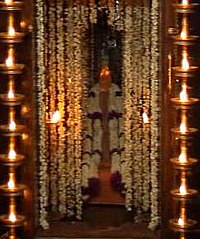
The Palliyarai contains two oil lamps (kuthuvilakku), an elunetru, and a large mirror. On a raised pedestal, covered with kavi cloth, the temple also preserves some articles believed to have been used by Ayya Vaikundar, including a rattan cane (perampu) and a pair of wooden sandals.
Portal:Religion/Selected picture/16

Kodiyettru Thirunal is the festival celebrated in Swamithope pathi for eleven days by the followers of the Ayyavazhi. This is celebrated three times annually during the Tamil months of Aavani, Thai and Vaikaasi. The festival for the month of Vaikasi is considered the most sacred and is celebrated in a grand scale.
Portal:Religion/Selected picture/17

The bagua (Chinese: 八卦; pinyin: bā guà; Wade–Giles: pa kua; lit. 'eight symbols') is a fundamental philosophical concept in ancient China. It is an octagonal diagram with one trigram on each side. The concept of bagua is applied not only to Chinese Taoist thought and the I Ching, but is also used in other domains of Chinese culture, such as fengshui, martial arts, navigation, and so on.
Portal:Religion/Selected picture/18

Joan of Arc, also known as Jeanne d'Arc, was a national heroine of France and is a canonized saint of the Roman Catholic Church. She asserted that she had visions from God which told her to recover her homeland from English domination late in the Hundred Years' War.
Portal:Religion/Selected picture/19

Dante And Virgil In Hell, which according to many religious beliefs, is a place or a state of suffering where the wicked or unrighteous dead are punished.
Portal:Religion/Selected picture/20
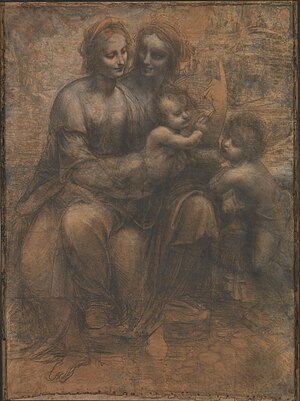
The Virgin and Child with St Anne and St John the Baptist, sometimes called The Burlington House Cartoon, is a full-size cartoon by Leonardo da Vinci.
Pictures 21–40
[edit]Portal:Religion/Selected picture/21

Avalokiteśvara or Avalokiteshvara (Sanskrit, lit. "Lord who looks down") is the bodhisattva who embodies the compassion of all Buddhas. He is the most widely revered bodhisattva in Buddhism.
Portal:Religion/Selected picture/22
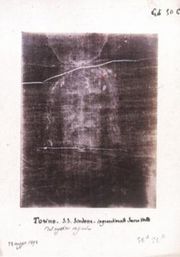
The Shroud of Turin (or Turin Shroud) is an ancient linen cloth bearing the image of a man who appears to have been physically traumatized in a manner consistent with crucifixion. The image can not be seen on the shroud with the naked eye and for several centuries the shroud had been displayed without it. The image was first observed in 1989 on the reverse photographic plate when amateur photographer Secondo Pia was unexpectedly allowed to photograph it. Some believe it is the cloth that covered Jesus when he was placed in his tomb. Skeptics contend the shroud is a medieval hoax or forgery.
Portal:Religion/Selected picture/23

Radha (Devanagari: राधा) is a famous female personality from Hindu, (Vedic) tradition, also known as Radharani, prefixed with the respectful term 'Srimati' by devout followers. Radha is almost always depicted alongside her paramour Krishna, and has a highly prominent feature within the philosophy of today's Gaudiya Vaishnava religions who believe Radha to be the original goddess Lakshmi.
Portal:Religion/Selected picture/24

Depiction of a rabbi blowing a shofar. The Hebrew inscription at the top reads: "To [a] Good Year." A shofar /ˈʃoʊfər/; Heb.: שופר) is a horn that is used as a musical instrument for Jewish religious purposes. It is intimately connected with both Rosh Hashanah and Yom Kippur. The shofar originated in Israel for Jewish callings.
Portal:Religion/Selected picture/25

Prometheus. The Greek myth of Prometheus was first attested by Hesiod and then constituted the basis for a tragic trilogy of plays, possibly by Aeschylus, consisting of Prometheus Bound, Prometheus Unbound and Prometheus Pyrphoros.
Portal:Religion/Selected picture/26

Harmandir Sahib or Darbar Sahib (also Hari Mandi', Harimandar and other variants; Punjabi: ਹਰਿਮੰਦਰ ਸਾਹਿਬ or ਹਰਿਮੰਦਿਰ ਸਾਹਿਬ) is the most sacred shrine in Sikhism, located in Amritsar, Punjab, India. It is widely known as the Golden Temple. Literally, Harimandir means "the Temple of God", 'Hari' being a term for God and 'Mandir' meaning Temple. Sikh devotees, for whom the Temple is a symbol of freedom and spiritual independence, come to the Temple from all over the world to enjoy its environs and offer their prayers.
Portal:Religion/Selected picture/27
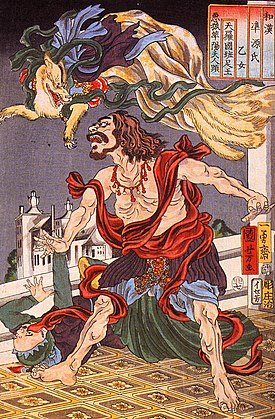
Kitsune is the Japanese word for fox. Kitsune have become closely associated with Inari, a Shinto kami or spirit, and serve as his messengers.
Portal:Religion/Selected picture/28
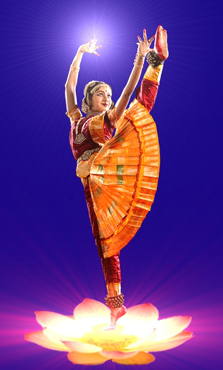
Bharatanatyam is a classical dance form originating from Tamil Nadu, a state in Southern India. This popular Tamil dance form is a gentrified version of Cathir, the art of temple dancers.
Portal:Religion/Selected picture/29
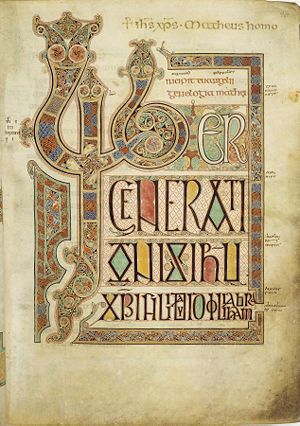
The Lindisfarne Gospels is an illuminated Latin manuscript of the gospels of Matthew, Mark, Luke and John.
Portal:Religion/Selected picture/30

In the history of science, alchemy refers to both an early form of the investigation of nature and an early philosophical and spiritual discipline, both combining elements of chemistry, metallurgy, physics, medicine, astrology, semiotics, mysticism, spiritualism, and art.
Portal:Religion/Selected picture/31

Sir Thomas More, the patron saint of lawyers and statesmen, coined the word "utopia", a name he gave to an ideal, imaginary island nation.
Portal:Religion/Selected picture/32

In Greek mythology, Achilles, also Akhilleus or Achilleus (Ancient Greek Ἀχιλλεύς) was a hero of the Trojan War, the central character and greatest warrior of Homer's Iliad, which takes for its theme, not the War of Troy in its entirety, but specifically the Wrath of Achilles.
He is known for being the most 'handsome' of the heroes assembled at Troy, as well as the fleetest. Central to his myth is his relationship with Patroclus, characterized in different sources as deep friendship or love.
Portal:Religion/Selected picture/33
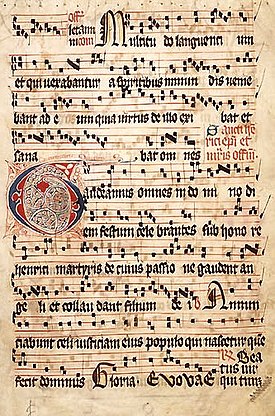
Gregorian chant is the central tradition of Western plainchant, a form of monophonic, unaccompanied sacred song of the Roman Catholic Church.
Portal:Religion/Selected picture/34

In Scientology doctrine, Xenu (also Xemu) was the alien dictator of the "Galactic Confederacy" who, 75 million years ago, brought billions of aliens to Earth in DC-8-like spacecraft, stacked them around volcanoes and blew them up with hydrogen bombs. Their souls then clustered together and stuck to the bodies of the living, and continue to wreak chaos and havoc today.
Portal:Religion/Selected picture/35
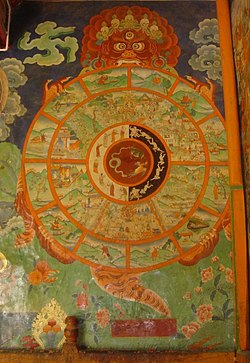
The Bhavacakra (Sanskrit, भवचक्र) or Wheel of becoming (Tibetan srid.pa'i 'khor.lo) is a complex symbolic representation of saṃsāra in the form of a circle (mandala), used primarily in Tibetan Buddhism. Saṃsāra is the continuous cycle of birth, life, and death from which one liberates oneself through enlightenment.
Portal:Religion/Selected picture/36

Battle at Lanka, Ramayana by Sahibdin. It depicts monkey army of the protagonist Rama (top left, blue figure) fighting the demon-king of the king of Lanka, Ravana in order to save Rama's kidnapped wife Sita. The painting depicts multiple events in the battle against the three-headed demon general Trisiras, in bottom left - Trisiras is beheaded by the monkey-companion of Rama - Hanuman.
Portal:Religion/Selected picture/37
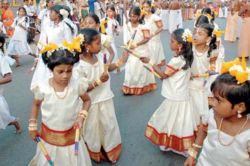
The Ayya Vaikunda Avataram (Tamil: அய்யா வைகுண்ட அவதாரம் - Incarnation of Vaikundar), is a festival celebrated by the followers of Ayyavazhi on the 20th day of the Tamil Month of Masi, the date on which the Ayyavazhi followers believe that Lord Vaikundar arose from the sea at Thiruchendur. And the 'Tha Great Masi Procession' is the Procession from Nagercoil to Swamithope.
Portal:Religion/Selected picture/38

The sahasrara ('1008 petal' arrangement) used as roof-architecture in a Nizhal Thangal. This is a new way of architecture used in constructing Nizhal Thangals.
Portal:Religion/Selected picture/39

An Octo-circular Ayyavazhi Nizhal Thangal constructed in Tamil Nadu with the 'Sahasrara' Architecture, the symbol of Ayyavazhi.
Portal:Religion/Selected picture/40

According to doctrine of the Latter Day Saint movement, the plan of salvation (also known as the plan of happiness) is a plan that God created to save, redeem, and exalt humankind. The elements of this plan are drawn from various sources, including the Bible, Book of Mormon, Doctrine & Covenants, Pearl of Great Price, and numerous statements made by the leadership of The Church of Jesus Christ of Latter-day Saints.
Nominations
[edit]Feel free to add related featured pictures to the above list. Other pictures may be nominated here.
